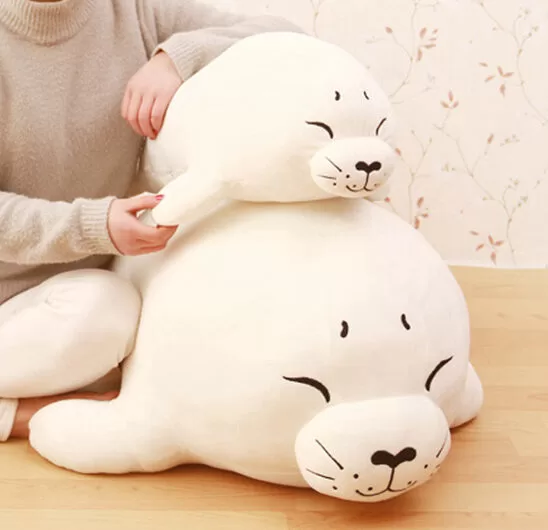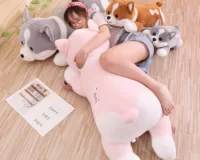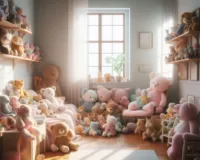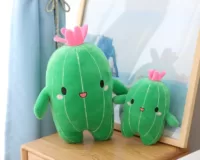Plushies and stuffed animals are more than just toys. They are cherished companions that bring warmth to our hearts and homes. However, over time, these beloved toys can accumulate dust, affecting their lifespan and causing allergies. It’s important to keep them clean and free from dust to maintain their charm. In this section, we will explore effective methods to keep your plush toys and stuffed animals dust-free.
To ensure that your stuffed animals remain in pristine condition, it’s essential to adopt a regular cleaning routine. By following these tips, you can prevent dust buildup and maintain the beauty of your plush toys. So, let’s get started on how to keep stuffed animals dust-free.
Keywords: how to keep stuffed animals dust free, plushies, plush toys, stuffed animals
Regularly Vacuum Your Stuffed Animals
Stuffed animals are cherished toys that require regular cleaning to maintain their charm and extend their lifespan. One of the most effective methods to keep them dust-free is by regularly vacuuming them.
When vacuuming, use a soft brush attachment or the upholstery setting on your vacuum cleaner to gently remove dust from the surface of the toys. Be sure to pay attention to all the nooks and crannies where dust may accumulate.
Vacuuming your stuffed animals at least once a month can help prevent dust buildup and maintain their cleanliness. If your plush toys are particularly delicate, you may want to consider using a handheld vacuum cleaner or a lint roller to remove surface dust.
Regular vacuuming is a simple but effective way to keep your stuffed animals looking and feeling their best for years to come.
Wash Your Stuffed Animals
Washing your plush toys is a vital step in keeping them dust-free and hygienic. Before washing, check the label for any washing instructions. If the toy is safe to wash, follow the recommended method to prevent any damage to the fabric or the stuffing.
To get started, remove any loose dirt or debris by gently brushing the surface of the toy with a soft-bristled brush. Then, fill a sink or bathtub with lukewarm water and add a mild detergent. Place the toy in the water and gently agitate the water to create suds.
Allow the toy to soak for 10-15 minutes, then drain the soapy water and refill the sink with clean water to rinse the toy. Repeat the process until all the soap is removed. Avoid squeezing or wringing the toy, as this can damage the stuffing.
After rinsing, gently press the toy to remove excess water. Place it on a clean towel and gently shape it back to its original form. Avoid laying it in direct sunlight or using a dryer, as this can also damage the fabric and the stuffing.
Tip:
To maintain the quality of the toy, avoid washing it too frequently. As a general rule, wash your stuffed animals once every six months or as needed.
Brushing and Spot Cleaning: Effective Methods to Keep Your Stuffed Animals Dust-Free
Regularly brushing your stuffed animals with a soft-bristled brush can help remove surface dust and keep them looking clean and fresh. Additionally, spot cleaning any visible stains or dirt can prevent them from becoming embedded in the fabric, keeping your plush toys dust-free for longer.
To brush your stuffed animals, gently run the brush over the surface of the toy, paying special attention to any areas where dust may accumulate, such as around the eyes or nose. Brushing your toys once a week is sufficient to keep them dust-free, but you can increase the frequency if you notice a buildup of dust.
To spot clean your plush toys, use a mild soap and water solution or a fabric cleaner specifically designed for stuffed animals. Apply the cleaner to a soft cloth, and gently dab the affected area, being careful not to saturate the fabric. Rinse the cloth with clean water, and repeat the process until the stain is lifted. Allow the toy to air dry completely before returning it to its usual spot.
Keep Stuffed Animals Away from Dusty Areas
Dusty areas are the enemy of plush toys. To prevent dust buildup, it’s crucial to keep your stuffed animals away from these areas. Avoid placing them near windows or vents where dust particles can easily enter. Instead, consider keeping them on shelves or display cases to minimize their exposure to dust.
Use Protective Covers
Using protective covers for your plush toys can provide an extra layer of defense against dust. Look for covers made of breathable materials that allow air circulation while keeping dust out. These covers can be especially useful if you’re storing your stuffed animals for an extended period.
Regularly Dust the Display Area
Keeping the display area clean is essential to protect your stuffed animals from dust. Dust surfaces such as shelves, cabinets, or display cases regularly to prevent dust from settling on the toys. Use a microfiber cloth or a feather duster for effective dust removal.
Avoid Direct Sunlight
Direct sunlight can cause fading of colors in your plush toys and attract more dust. Therefore, keep your stuffed animals away from windows or any other areas where they are exposed to prolonged sunlight. Instead, choose a shaded spot to display or store them.
Store Stuffed Animals Properly
If you’re not displaying your stuffed animals, proper storage is crucial to protect them from dust. Use airtight containers or sealed bags to protect the toys when storing them. Make sure the toys are clean and completely dry before packing them away.
Regularly Rotate Your Stuffed Animals
To prevent dust from settling in one spot, regularly rotate your stuffed animals. Switch their positions or bring out different toys to display, ensuring that each toy gets equal exposure and cleaning attention.
Use Protective Covers to Keep Your Plush Toys Dust-Free
Protective covers are an excellent way to safeguard your plush toys against dust and other contaminants. Not only do they keep the toys clean, but they also maintain their quality and prolong their lifespan. Here are some things to consider when choosing protective covers:
- Material: Look for covers made of breathable materials, such as cotton or linen, which allow air circulation while keeping dust out. Avoid covers made of plastic or synthetic materials, which can trap moisture and cause mildew on your furry companions.
- Size: Ensure that the cover is the right size for your toy. A cover that’s too large can trap dust and debris, while one that’s too small can damage the toy by compressing it.
- Maintenance: Choose covers that are easy to maintain and clean. Machine washable covers are ideal, as they can be cleaned regularly to prevent the buildup of dust and bacteria.
To use protective covers effectively, first, ensure that your plush toy is clean and dry. Then, gently place it inside the cover and seal it tightly to prevent any dust or debris from entering. You can also label the cover to keep track of the toy’s name or date of storage.
Using protective covers is an effective way to keep your plush toys dust-free, especially if you plan to store them for long periods. By choosing breathable materials, ensuring the proper size, and maintaining the covers, you can keep your furry companions in top condition and dust-free.
Regularly Dust the Display Area
A clean display area is essential to keep dust away from your plush toys. Dust surfaces such as shelves, cabinets, or display cases regularly to prevent dust from settling on the toys. Use a microfiber cloth or a feather duster for effective dust removal.
- Dust display area. Regular dusting of the shelves, cabinets or display cases where you keep your plush toys is essential to keep them dust-free. Wipe the surfaces with a clean microfiber cloth or a feather duster to remove any dust particles.
- Use a feather duster or microfiber cloth. Instead of using a regular cloth or paper towel, use a microfiber cloth or a feather duster to remove dust. These tools are more effective in trapping dust particles and preventing them from spreading around the area.
- Don’t forget the corners. When dusting your display area, be sure to pay attention to the corners where dust tends to accumulate. Use a soft-bristled brush to remove any dust particles from these hard-to-reach spots.
Avoiding Direct Sunlight to Keep Your Plush Toys Dust-Free
Direct sunlight can be harmful to your plush toys, causing their colours to fade and attracting more dust. It’s important to keep them away from windows or any other areas where they may be exposed to sunlight for prolonged periods.
Instead, choose a shaded spot to display or store your plush toys. Consider using blinds or curtains to regulate the amount of sunlight entering the room.
Another option is to use a protective cover made of breathable materials that allow air circulation while keeping dust out. This can be especially useful if you’re storing your plush toys for an extended period.
Remember that a clean display area is also essential to keep dust away from your stuffed animals. Dust surfaces such as shelves, cabinets or display cases regularly to prevent dust from settling on the toys. Use a microfiber cloth or a feather duster for effective dust removal.
By taking these steps, you can ensure that your plush toys remain dust-free and retain their charm for years to come.
Store Stuffed Animals Properly
Proper storage is essential to keep your plush toys dust-free and in good condition. Whether you are looking to store your stuffed animals long-term or just for a short period, following these tips can help:
- Ensure your stuffed animals are clean and dry: Before storing your plush toys, make sure they are completely clean and dry. Any dirt or moisture left on the toys can attract dust and cause damage over time.
- Use airtight containers: Airtight containers are a great way to protect your stuffed animals from dust and other elements. Make sure the container is not too tight and allows for some air circulation.
- Sealed bags: Sealed bags can also be a good option for storing your plush toys. Use bags made of breathable materials to prevent moisture buildup.
- Avoid storing in damp areas: Moisture can cause mould and mildew to grow on your stuffed animals, so avoid storing them in damp areas like basements or attics.
- Label containers: Labeling your storage containers can make it easier to quickly identify which toys are inside without opening them and exposing the stuffed animals to dust.
By following these tips, you can ensure that your stuffed animals stay dust-free and in good condition while they are in storage.
Regularly Rotate Your Stuffed Animals
Don’t let dust settle in just one spot! An effective method to prevent dust buildup on your stuffed animals is regularly rotating them. This means switching their positions or bringing out different toys to display. By doing so, you ensure that each toy gets equal exposure and cleaning attention.
This is especially important if you have a collection of plush toys or if you keep them in a display case. By rotating them, you can also avoid any potential fading from prolonged sunlight exposure in specific areas.
Make it a habit to rotate your stuffed animals every few weeks or months. Not only will it help keep them dust-free, but it’s also an excellent way to appreciate and enjoy your entire collection.
Conclusion
Stuffed animals are cherished toys that provide comfort and companionship. However, dust accumulation can cause allergies and affect the lifespan of these toys. By following the tips mentioned in this article, you can keep your stuffed animals dust free and maintain their charm for years to come.
Regular cleaning, proper storage, and avoiding dusty areas are key to keeping your plush toys dust free. Washing, vacuuming, and brushing are effective methods to remove dust and dirt from the surface of the toys. Protective covers and proper storage can provide an extra layer of defense against dust. Additionally, regularly rotating your stuffed animals can prevent dust from settling in one spot.
Keeping your stuffed animals dust free not only reduces the risk of allergies but also ensures their longevity. With proper care and maintenance, you can enjoy the companionship of your plush toys for years. So, follow these tips, keep your cherished stuffed animals clean and dust free, and enjoy their company for many more years to come.
FAQ
How often should I vacuum my stuffed animals?
It is recommended to vacuum your stuffed animals at least once a month to remove dust from the surface and prevent allergies.
Can I wash my stuffed animals in the washing machine?
Whether you can wash your stuffed animals in the washing machine depends on the toy’s label. If it is safe to wash, use a gentle detergent and wash on a delicate cycle. Air dry the toy completely before returning it to its usual spot.
How do I brush my stuffed animals?
Use a soft-bristled brush to gently brush your stuffed animals and remove surface dust. Be careful not to damage the fabric or any delicate details.
What should I do if there are stains on my stuffed animals?
Spot clean visible stains or dirt on your stuffed animals using a mild soap and water solution or a fabric cleaner designed for plush toys.
How can I prevent dust from accumulating on my stuffed animals?
Keep your stuffed animals away from dusty areas in your home, such as windows or vents. Consider using protective covers made of breathable materials and regularly dust the display area to prevent dust settling on the toys.
Should I avoid placing my stuffed animals in direct sunlight?
Yes, direct sunlight can fade the colors of your stuffed animals and attract more dust. Choose a shaded spot to display or store them.
How should I store my stuffed animals?
When storing your stuffed animals, use airtight containers or sealed bags to protect them from dust. Ensure the toys are clean and completely dry before packing them away.
How often should I rotate my stuffed animals?
It is recommended to regularly rotate your stuffed animals to prevent dust from settling in one spot. Switch their positions or bring out different toys to display and clean equally.
How can I extend the lifespan of my stuffed animals?
By following the tips mentioned, you can keep your stuffed animals dust free and minimize the risk of allergies, thus extending their lifespan.





